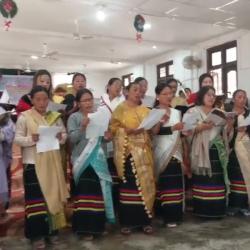Nagaland's Wokha District has been bustling with excitement since the first batch of Amur falcons arrived in the Doyang Reservoir area last week. Upon the arrival of their special guests, the villagers of Ashaa, Pangti and Sungro once again reaffirmed their last year’s commitment and dedication to protect the falcons with the support of Wildlife Trust of India (WTI) and the Nagaland Forest Department.
In their incredible journey, the Amur falcons (Falco amurensis), travel from Mongolia, roost in Nagaland for over a month before carrying onwards to the African sub-continent. A protected species under the Convention of Migratory Species (CMS), tens of thousands of these raptors congregate near the Doyang reservoir in Nagaland every year and this is believed to be the single largest congregation of Amur falcons recorded anywhere in India.

In 2012, reports from Conservation India highlighted that majority of the birds were being hunted, prompting a Rapid Action Project (RAP) to protect the birds by WTI and Natural Nagas with the assistance of the State Forest Department supported by CAF India. An awareness campaign was initiated to gain the local community's support and also sensitize them on the need to conserve the visiting guests. Awareness meetings conducted in different parts of Wokha emphasised the ecological and ethical importance of the Amur falcons and urged villagers to ensure safe passage of these migratory birds. The local community including the village council heads and local forest department authorities enthusiastically participated in this campaign demonstrating their support to the cause. Local churches also played a key role in spreading the message of compassion for Amur falcon, and thus motivating the community to come forward to protect the falcons during their roosting period in Nagaland.
An MoU was signed and a subsequent resolution passed by the village councils of Pangti, Ashaa and Sungro, making hunting Amur falcons illegal and punishable, which helped in reaching a zero mortality rate in Doyang, by the end of the birds' roosting period.
This year with the return of the birds to Nagaland a 'Welcome Programme' was organised by the Forest Department in the honour of the falcons on October 1, 2014, at Pangti village, with support from WTI and the District Administration. Forest Minister of Nagaland, Dr Nicky Kire as the Chief Guest inaugurated two watch towers- one constructed by the State Forest Department and the other by Nagaland Bamboo Mission- to witness the phenomenon of mass migration of these birds. The Minister also distributed the equipment given by WTI to the protection squads constituted in the roosting area.

Underlining success of conservation efforts, Ms. Zuthunglo Patton, DFO Doyang said,"Starkly against the general perception of Naga people being compulsive hunters, the success of Amur Falcon conservation has put Nagaland on the global map; and the sheer number of the Amur Falcon population here has made it the "Falcon Capital of the world". Focused and relentless awareness in the last one year has brought about this success. The communities of Pangti and adjoining villages in Wokha District have turned the spectacular migration of these magnificent birds into a lifetime opportunity for tourists whose jaws drop in utter amazement over the unforgettable sight ".
"The Welcome Programme served as a useful platform for discussing strategic plans for helping conserve the Amur falcons this year and in future as well. Last year, thanks to the wonderful support of the department and the villagers, we were able to form Protection Squads of around 30 former hunters. The same squads are going to patrol the area this year as well to make sure that all visiting falcons are safe, and not a single one is harmed," said Dr Jagdish Kishwan, Chief Advisor to the ED & CEO Wildlife Trust of India.
“The conservation wave for the protection of the migrating guests has already been ignited in this area. This signals a hope and a model through-out Nagaland in protecting the rich biodiversity of the state,” said Sunil Kyarong, Regional Head of Arunachal Pradesh, Meghalaya and Nagaland for WTI.
As a side corollary of the Amur falcon project, and to build trust of the local communities, an assessment will also be carried out on Human-Elephant Conflict (HEC) for mitigation solutions in the Bhagti Valley and Pangti area of Wokha District facing high degree of depredation from over 100 pachyderms trapped with no corridors or migration routes to exit. Last year, for the first time in Nagaland, a 'Grain for Grain' scheme was implemented in Pangti village of Wokha, through which support was provided in the form of grain for 99 families affected by elephant depredation.
As of now, after seeing the time line of Amur falcons arrival it was more than last year," said Dilip Deori, Assistant Manager, Wildlife Trust of India.
"The Amur falcons also stop in Dima Hasao, which is near Karbi Anglong, Assam, for a few weeks during October and November. During this period, the falcons are hunted and trade in Dima Hasao. Keeping the success of last year's awareness programmes, in Nagaland, a Rapid Action Project has also been started in the area to encourage locals to help conserve these birds which play an important role in the eco-system by helping check the insect population," said Radhika Bhagat, Head of the Wild Aid Division which carries out the Rapid Action Projects.
The RAP project team is going to hold consultative meetings with the Dima Hasao Autonomous Council members along with the Forest Department authorities and the local village heads. The team is also pushing for a resolution against hunting of Amur falcons in Umrangso.

- 8102 reads










Add new comment